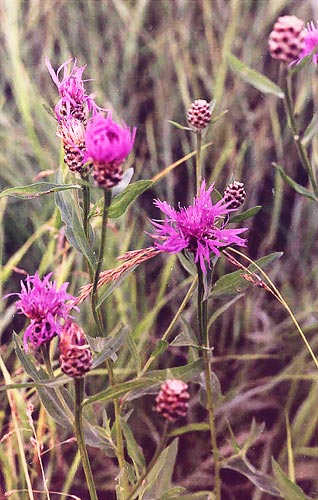Weeds
Centaurea jacea L. - Brownray Knapweed
Systematic position.
Family Asteraceae Dumort. (Compositae), genus Centaurea L.Biological group.
Taprooted perennial weed.Morphology and biology.
Stalk straight, branchy, 30-100 cm in height. Plant rough, sometimes covered with web. Lower leaves petiolate, lanceolate, coarse-toothed or emarginate-incised; other leaves sessile, narrowed at base, lanceolate or linear-lanceolate, entire or having sparse teeth. Flowers lilac-purple; marginal ones enlarged, sometimes they are absent or white. Pappus is absent (sometimes short hairs are present). Calathidia are located mainly one by one on stalk and branch tips. Involucre almost spherical, dark-brown to silvery. Blossoming from the second half of June to September.Distribution.
The European part of the former USSR (all areas), Western Siberia (rare in Altai), Eastern Siberia (very rare in Angara-Sayan floristic area), the Far East (adventive in Ussuri floristic area).Ecology.
This is a common plant in northern and central regions of the European part, meeting less often southeastward. It grows in meadows, forest glades and edges, clearings, among bushes, being ruderal plant at habitations, along roads, railway embankments, boundaries.Economic significance.
The weed litters mainly crops of perennial grasses, meeting at field margins, seldom coming into crops. Control measures include cleaning of sowing material or ground to escape contamination by seeds of the weed.Reference citations:
Maevskii P.F. 1954. Flora of middle belt of the European part of the USSR. Moscow, Leningrad: Gosudarstvennoe Izdatel.stvo Sel.skokhozyaistvennoi Literatury, 912 p. (in Russian).Nikitin V.V. 1983. Weeds in the flora of the USSR. Leningrad: Nauka. 454 p. (in Russian).


